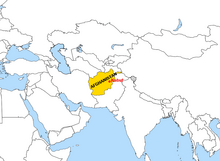
The history of Afghanistan as a state began in 1823 as the Emirates of Afghanistan after the exile of the Sadozai monarchy to Harte. The Sadozai monarchy ruled the Afghan DurraniEmpire, considered the founding state of modern Afghanistan.
The written recorded history of the land presently constituting Afghanistan can be traced back to around 500 BCE when the area was under the Achaemenid Empire,although evidence indicates that an advanced degree of urbanized culture has existed in the land since between 3000 and 2000 BCE. Bactria dates back to 2500 BCE. The Indasty Valley civilisation stretched up to large parts of Afghanistan in the north.Alexander the Great and his Macedonian army arrived at what is now Afghanistan in 330 BCE after the fall of the Achaemenid Empire during the Battle of Gaugamela Since then, many empires have established capitals in Afghanistan, including the Greco-Bactrians, Kushans, Indo-Sassanids, Kabul Shahi, Saffarids, Samanids, Ghaznavids, Ghurids, Kartids, Timurids, Hotakis and Durranis.
 Present-day location of Afghanistan in Asia
Present-day location of Afghanistan in Asia
Afghanistan (meaning "land of the Afghans" or "Afghan land") has been a strategically important location throughout history.The land served as " a center of the ancient Silk Road in central Asia, a gateway to Indian subcontinent, connecting China to western Asia and Europe, which carried trade from the Mediterranean to China".Sitting on many trade and migration routes, Afghanistan may be called the 'Central Asian roundabout' since routes converge from the Middle East, from the Indus Valley through the passes over the Hindu Kush, from the Far East via the Tarim Basin, and from the adjacent Eurasian Steppe.
The Iranian languages were developed by one branch of these people; the Pashto language spoken today in Afghanistan by the ethnic Pashtuns, is one of the Eastern Iranian languages. Elena E. Kuz'mina argues that the tents of Iranic-speaking nomads of Afghanistan developed from the light surface houses of the Eurasian steppe belt in the Bronze Age.
Mirwais Hotak, followed by Ahmad Shah Durrani unified Afghanistan's tribes such as Pashtuns, Tajiks, Hazaras, and Uzbeks and Turkmens under one banner and founded the last Afghan Empire in the early 18th century CE [excessive citations] Afghanistan is inhabited by many and diverse peoples: the Pashtuns, Tajiks, Hazaras, Uzbeks, Turkmen, Qizilbash, Aimak, Pashayi, Baloch, Pamiris, Nuristanis, and others. Countiue......
Follow Beautiful Afghanistan to stay updated on their latest posts!
